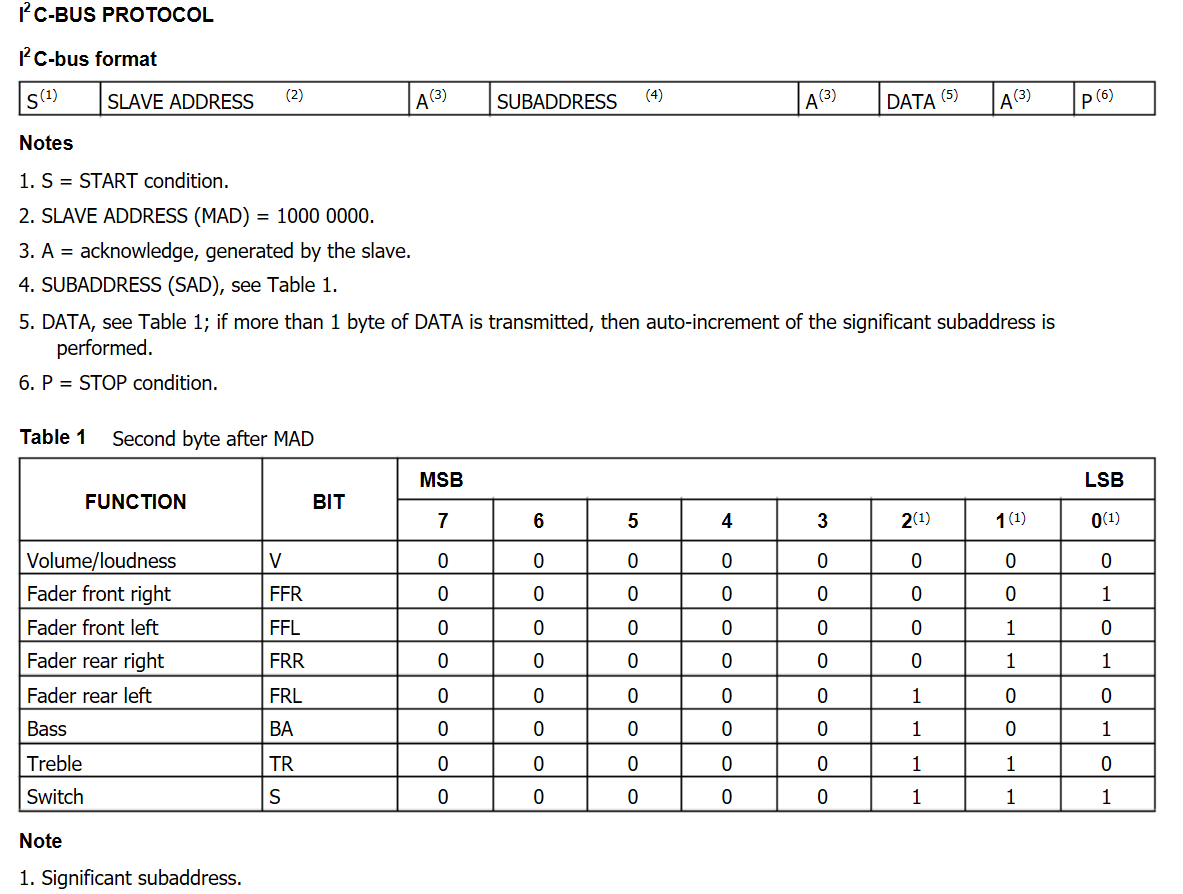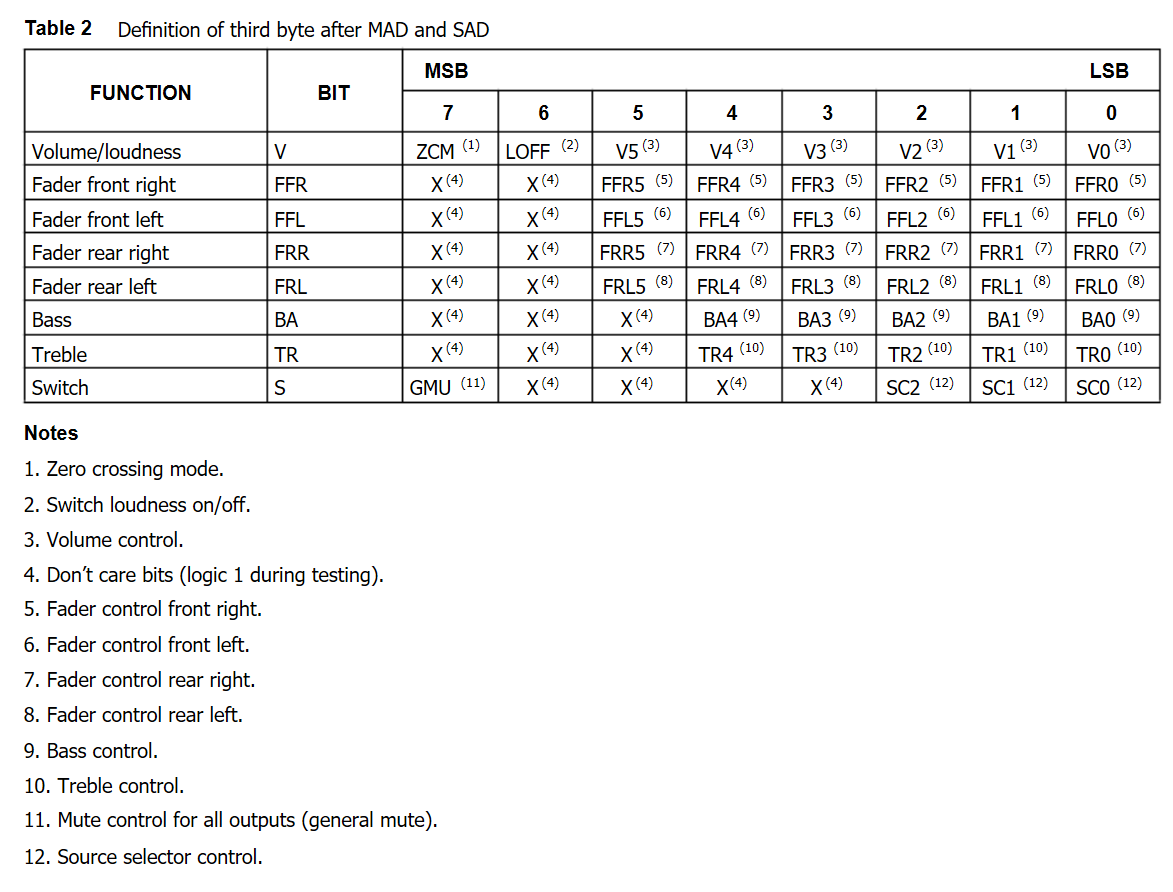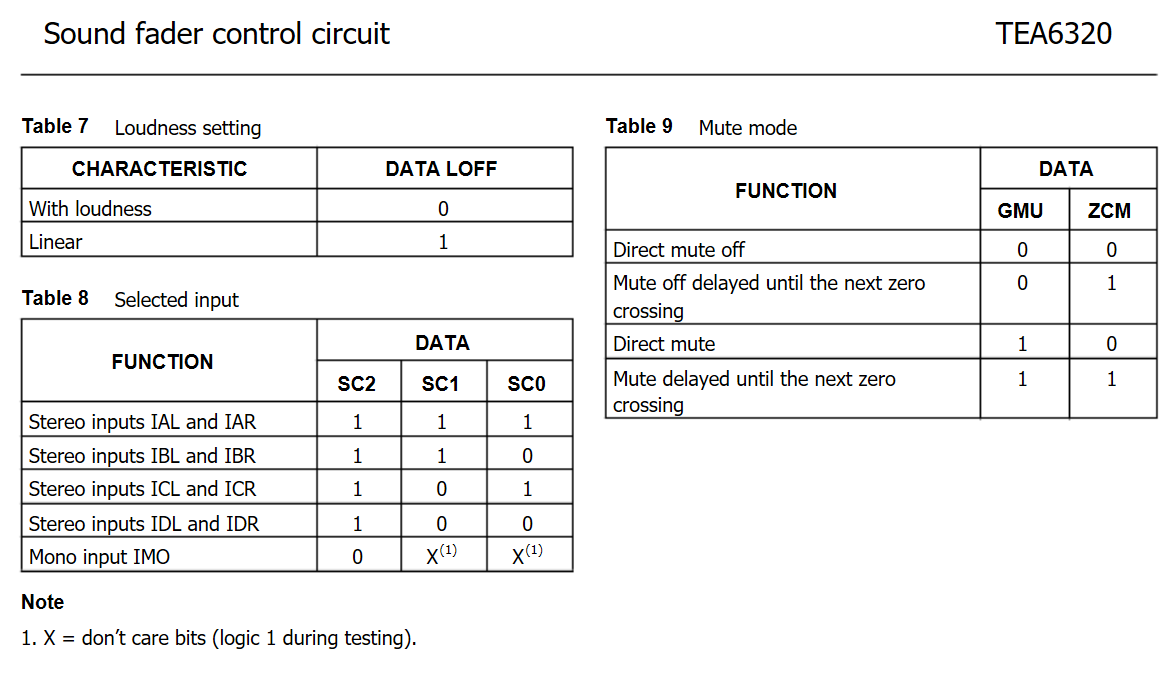现在先了解一下TEA6320,TEA6320是一个I2C总线控制音响应用的立体声放大器,,它的I2C协议和音量控制如下:



它的主要代码:
void delay1ms(unsigned int Delay ) //1ms延时
{
unsigned int j; for(;Delay>0;Delay--) for(j=0;j<125;j++); } void init() ///总线初始化 将总线都拉高一释放总线 发送启动信号前,要先初始化总线。即总线检测到总线空闲才开始发送启动信号 { SDA=1; _nop_(); SCL=1; _nop_(); } void InitUART(void) { TMOD = 0x20; //将Timer1设置为Mode2以产生波特率 SCON = 0x50; //串口工作方式2 TH1 = 0xfd; //波特率9600 TL1 = TH1; PCON = 0x00; //将SMOD设置为0 TR1 = 1; //开启定时器1 EA=1; //开启总中断 ES=1; //开启串口中断 } void SendData(uchar Dat) //发送数据 { ACC = Dat; CY=P; TB8=~CY; SBUF=ACC; while(!TI); TI = 0; //软件复位 } void I2C_start() { SDA=1; //起始信号 _nop_(); SCL=1; _nop_(); _nop_(); _nop_(); _nop_(); _nop_(); SDA=0; _nop_(); _nop_(); _nop_(); _nop_(); _nop_(); } void I2C_stop() { SDA=0; //停止信号 _nop_(); SCL=1; _nop_(); _nop_(); _nop_(); _nop_(); _nop_(); SDA=1; _nop_(); _nop_(); _nop_(); _nop_(); _nop_(); } void ack() //应答信号 { SDA=0; _nop_(); SCL=1; _nop_(); SCL=0; _nop_(); // SDA = 1; // SCL = 1; // _nop_(); // while(SDA==1); // SCL = 0; } void I2C_sendByte(unsigned char dat) //发送数据 {
unsigned char temp; unsigned char i; SCL=0; _nop_(); _nop_(); _nop_(); _nop_(); for(i=0;i<8;i++) //要发送的数据长度为8位 { temp=dat; if(temp<<i&0x80) SDA=1; //判断发送位 else SDA=0; _nop_(); SCL=1; //置时钟线为高,通知从机开始接受数据位 _nop_(); _nop_(); _nop_(); //保证时钟高电平周期大于4us ` _nop_(); _nop_(); _nop_(); _nop_(); _nop_(); _nop_(); SCL=0; //拉低SCL,为下次数据传输做好准备 _nop_(); _nop_(); } SDA=1; //释放SDA总线,接下来由从设备控制,比如从设备接收完数据后,在SCL为高时,拉低SDA作为应答信号 _nop_(); _nop_(); _nop_(); _nop_(); } main() { InitUART(); init(); while(1) { CS=1; A10=0; A11=0; A12=0; A13=0; A14=0; OE=0; /*.....ENABLE变低,总线开始接受数据.....*/ ALE=0; bb=0; ii=P0; aa=0xff; V24=0; if(ii==0x8f) // 5个按钮不动作,关的状态 { delay1ms(50); if(ii==0x8f) { bb=0xf9; P0=bb; aa=0x11; delay1ms(200); CS=1; A10=1; A11=0; A12=0; A13=0; A14=0; WE=0; delay1ms(500); } } if(ii==0x8e) { delay1ms(50); if(ii==0x8e) { bb=0xf1; P0=bb; aa=0x11; delay1ms(200); CS=1; A10=1; A11=0; A12=0; A13=0; A14=0; WE=0; delay1ms(500); SendData(0xAA); I2C_start(); I2C_sendByte(0x80); //MAD,第一个字节 ack(); I2C_sendByte(0x00); //SAD,第二个字节 ack(); I2C_sendByte(0x2C); //响度 +20dB ack(); I2C_sendByte(0x3f); //前右 响度0dB ack(); I2C_sendByte(0x3f); //前左 响度0dB ack(); I2C_sendByte(0x3F); //后右 响度0dB ack(); I2C_sendByte(0x3F); //后左 响度0dB ack(); I2C_sendByte(0x10); //低音 响度+15dB ack(); I2C_sendByte(0x10); //高音 响度+15dB ack(); I2C_sendByte(0x7f); //声道选择 直接静音关闭,选通IAL和IAR ack(); I2C_stop(); delay1ms(5000); I2C_start(); I2C_sendByte(0x80); //MAD ack(); I2C_sendByte(0x00); //SAD ack(); I2C_sendByte(0x2C); //响度 +20dB ack(); I2C_sendByte(0x3f); //前右 响度0dB ack(); I2C_sendByte(0x3f); //前左 响度0dB ack(); I2C_sendByte(0x3F); //后右 响度0dB ack(); I2C_sendByte(0x3F); //后左 响度0dB ack(); I2C_sendByte(0x10); //低音 响度+15dB ack(); I2C_sendByte(0x10); //高音 响度+15dB ack(); I2C_sendByte(0xff); //声道选择 直接静音,选通IAL和IAR ack(); I2C_stop(); SendData(0x55); } } if(ii==0x8d) //4脚按钮动作处于开的状态 { delay1ms(50); if(ii==0x8d) { bb=0xe9; P0=bb; aa=0x11; delay1ms(200); CS=1; A10=1; A11=0; A12=0; A13=0; A14=0; WE=0; delay1ms(500); SendData(0xAA); I2C_start(); I2C_sendByte(0x80); //MAD ack(); I2C_sendByte(0x00); //SAD ack(); I2C_sendByte(0x2C); //响度 +20dB ack(); I2C_sendByte(0x3f); //前右 响度0dB ack(); I2C_sendByte(0x3f); //前左 响度0dB ack(); I2C_sendByte(0x3F); //后右 响度0dB ack(); I2C_sendByte(0x3F); //后左 响度0dB ack(); I2C_sendByte(0x10)